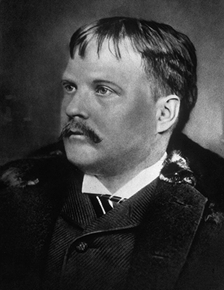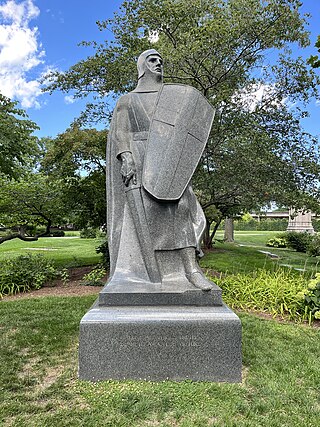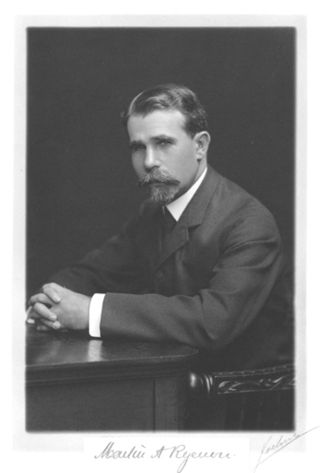
Louis Henry Sullivan was an American architect, and has been called a "father of skyscrapers" and "father of modernism." He was an influential architect of the Chicago School, a mentor to Frank Lloyd Wright, and an inspiration to the Chicago group of architects who have come to be known as the Prairie School. Along with Wright and Henry Hobson Richardson, Sullivan is one of "the recognized trinity of American architecture." The phrase "form follows function" is attributed to him, although the idea was theorised by Viollet le Duc who considered that structure and function in architecture should be the sole determinants of form. In 1944, Sullivan was the second architect to posthumously receive the AIA Gold Medal.

Dankmar Adler was a German-born American architect and civil engineer. He is best known for his fifteen-year partnership with Louis Sullivan, during which they designed influential skyscrapers that boldly addressed their steel skeleton through their exterior design: the Wainwright Building in St. Louis, Missouri (1891), the Chicago Stock Exchange Building (1894), and the Guaranty Building in Buffalo, New York (1896).

Bellefontaine Cemetery is a nonprofit, non-denominational cemetery and arboretum in St. Louis, Missouri. Founded in 1849 as a rural cemetery, Bellefontaine is home to a number of architecturally significant monuments and mausoleums such as the Louis Sullivan-designed Wainwright Tomb, which is listed on the National Register of Historic Places.

John Wellborn Root was an American architect who was based in Chicago with Daniel Burnham. He was one of the founders of the Chicago School style. Two of his buildings have been designated a National Historic Landmark; others have been designated Chicago landmarks and listed on the National Register of Historic Places. In 1958, he was posthumously awarded the AIA Gold Medal.

Graceland Cemetery is a large historic garden cemetery located in the north side community area of Uptown, in Chicago, Illinois, United States. Established in 1860, its main entrance is at the intersection of Clark Street and Irving Park Road. Among the cemetery's 121 acres (49 ha) are the burial sites of several well-known Chicagoans.

Rosehill Cemetery is an American garden cemetery on the North Side of Chicago, Illinois, and at 350 acres (1.4 km2), is the largest cemetery in the City of Chicago. According to legend, the name "Rosehill" resulted from a City Clerk's error – the area was previously called "Roe's Hill", named for nearby farmer Hiram Roe. He refused to sell his land to the city until it was promised that the cemetery be named in his honor. It is located in the north east section of the Lincoln Square community area.

Richard Stanley Nickel was a Polish American architectural photographer and historical preservationist, who was based in Chicago, Illinois. He is best known for his efforts to preserve and document the buildings of architect Louis Sullivan, and the work of the architecture firm of Adler & Sullivan.
George Grant Elmslie was an American Prairie School architect whose works are is mostly found in the Midwestern United States. He worked with Louis Sullivan and later with William Gray Purcell as a partner in the firm Purcell & Elmslie.

The Wainwright Building is a 10-story, 41 m (135 ft) terra cotta office building at 709 Chestnut Street in downtown St. Louis, Missouri. The Wainwright Building is considered to be one of the first aesthetically fully expressed early skyscrapers. It was designed by Dankmar Adler and Louis Sullivan and built between 1890 and 1891. It was named for local brewer, building contractor, and financier Ellis Wainwright.

Solon Spencer Beman was an American architect based in Chicago, Illinois and best known as the architect of the planned Pullman community and adjacent Pullman Company factory complex, as well as Chicago's renowned Fine Arts Building. Several of his other largest commissions, including the Pullman Office Building, Pabst Building, and Grand Central Station in Chicago, have since been demolished. Beman designed numerous Christian Science churches and influenced the design of countless more.

The Carrie Eliza Getty Tomb, located in Graceland Cemetery in Chicago, Illinois, United States, was commissioned in 1890 by the lumber baron, Henry Harrison Getty, for his wife. It was designed by the noted American architect, Louis Sullivan of the firm Adler & Sullivan. Getty became familiar with Sullivan's work from the architect's various Loop projects as well as from the mausoleum Sullivan designed for Getty's late partner, Martin Ryerson.

Pettit Memorial Chapel or Pettit Chapel was designed by architect Frank Lloyd Wright and constructed in 1907. The Pettit Chapel is located in the Belvidere Cemetery in Belvidere, Illinois, United States, which is in Boone County. It was listed on the U.S. National Register of Historic Places December 1, 1978. The chapel is an example of Frank Lloyd Wright's famed Prairie Style. It is the only funerary structure designed by Wright to be built in his lifetime.

The Wainwright Tomb is a mausoleum located in Bellefontaine Cemetery in St. Louis, Missouri. Originally constructed for Charlotte Dickson Wainwright in 1892, the tomb also contains the remains of her husband, Ellis Wainwright. The mausoleum was designed by noted Chicago school architect Louis Sullivan, who also designed the Wainwright Building for Ellis Wainwright.

Ellis Wainwright was an American capitalist, brewer, art collector and socialite from St. Louis, Missouri. He was President of the St. Louis Brewing Company and Director of the St. Louis and Suburban Company. He is best known for the Wainwright Building in downtown St. Louis, which was one of the first skyscrapers in the world and one of the most important office buildings of the period.
Adler & Sullivan was an architectural firm founded by Dankmar Adler and Louis Sullivan in Chicago. Among its projects was the multi-purpose Auditorium Building in Chicago and the Wainwright Building skyscraper in St Louis. In 1883 Louis Sullivan was added to Adler's architectural firm, creating the Adler & Sullivan partnership. According to Architect Ward Miller:
Adler & Sullivan are most associated with being an innovative and progressive architectural practice, forwarding the idea of an American style and expressing this in a truly modern format. Their work was widely published and at the forefront of building construction. Their buildings and especially their multipurpose structures. .. were unequaled. Furthermore, the expression of a tall building, its structure with a definite base, middle section or shaft and top or cornice was a new approach for the high building design. These types of tall structures developed into a format.. .. Even today, the vertical expression of a building employs these design principals.

Eternal Silence, alternatively known as the Dexter Graves Monument or the Statue of Death, is a monument in Chicago's Graceland Cemetery and features a bronze sculpture of a hooded and draped figure set upon, and backdropped by, black granite. It was created by American sculptor Lorado Taft in 1909.

The Crusader, also known as the Victor Lawson Monument, is a memorial marking the grave of Chicago newspaper publisher Victor Lawson. It is in Chicago's historic Graceland Cemetery and was designed by American sculptor Lorado Taft in 1931.

The Schoenhofen Pyramid Mausoleum is a tomb in Graceland Cemetery, Chicago. It was designed by Chicago School architect Richard E. Schmidt as a family mausoleum for the Chicago brewer Peter Schoenhofen.

Martin A. Ryerson (1856–1932) was an American lawyer, businessman, philanthropist and art collector. Heir to a considerable fortune, he was a lumber manufacturer and corporate director. He became the richest man in Chicago by the age of 36. A long-time trustee of the University of Chicago, he made large charitable contributions for the construction of buildings on campus. He bequeathed his extensive art collection to the Art Institute of Chicago.



















